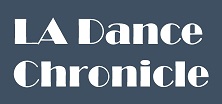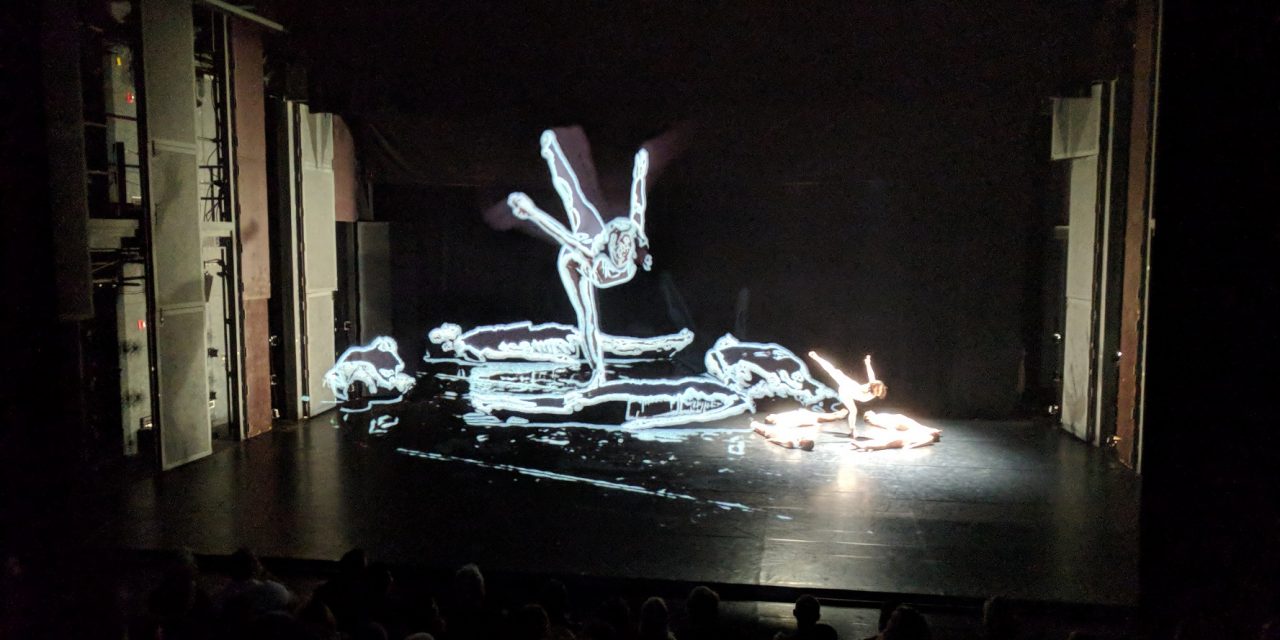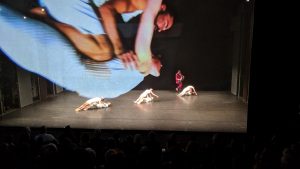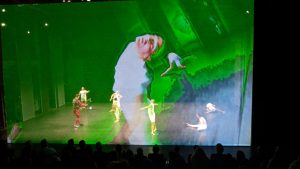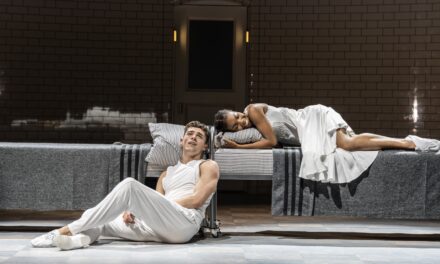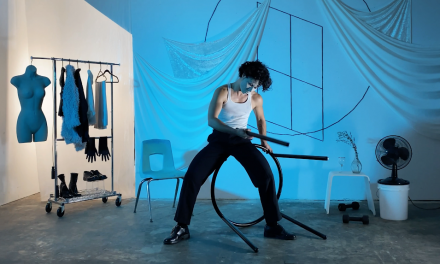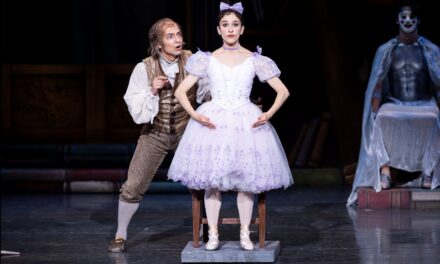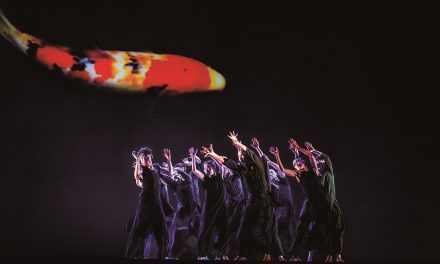This weekend The Roy and Edna Disney/CalArts Theater (REDCAT) is presenting Charles Atlas, Rashaun Mitchell, Silas Riener: TESSERACT, a wonderful combination of dance, live video feed and 3D-film. In geometry, the tesseract is the four-dimensional analog of the cube. The work is the result of a three-year collaboration between two former members of the Merce Cunningham Dance Company, Mitchell and Riener, and filmmaker and former filmmaker-in-residence for the Cunningham company, Charles Atlas. The first half of the program consists of a 3D-film directed and edited by Atlas. It includes several amazing sections that demonstrate the vast possibilities of dance on film, but it falls short of remaining cohesive throughout. The second half excels, however, with beautiful dancing and incredible live video projected against a downstage scrim that brings an exciting and new perspective of the action onstage. TESSERACT consists of some very innovative choreography, beautifully designed and constructed, futuristic costumes and electronic music.
Charles Atlas is a video artist and film director who also designs lighting and sets. He is a pioneer in developing media-dance, work that is created directly for the camera. He worked collaboratively with Merce Cunningham from 1975 to 1981 on such films as Changing Steps, Blue Studio: Five Segments, Fractions, Local and Channels/Inserts. Since his time with Cunningham, Atlas has worked independently in film while collaborating with other professionals in the field. He is the recipient of two Bessie Awards, a John Simon Guggenheim Memorial Foundation Fellowship, the 2000 Dance Screen Award for Best Documentary, Merce Cunningham: A Lifetime of Dance; and the 2003 Melbourne Queer Film Festival Award for Best Documentary, Legend of Leigh Bowery.
Since 2010 Rashaun Mitchell and Silas Riener worked together for years in the Merce Cunningham Dance Company and have since created dances “in response to complex and active spatial environments, often merging elements of fantasy, absurdity, and quiet contemplation into challenging multifaceted performance.” They have been part of Lower Manhattan Cultural Council’s Extended Life Dance Development program, the New York City Center Choreographic Fellowship, and have been artists in residence at museums, festivals and art institutions. Both men are recipients of Performance Bessie Awards and together they were named among Dance Magazine’s “25 to Watch” list in 2013.
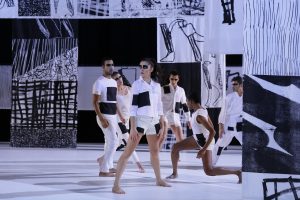
Charles Atlas / Rashaun Mitchell / Silas Riener, Tesseract. Pictured from left to right: Rashaun Mitchell, Cori Kresge, Melissa Toogood, Silas Riener, Kristen Foote, and David Rafael Botana. Photo: © Mick Bello / EMPAC
For the first half, the audience is given 3D glasses as they enter and projected on the screen is an orange and white cube that becomes focused as one puts them on. Parts of the film’s introduction makes one harken back to the beginning of the 1968 Stanley Kubrick fantasy/Sci-Fi film 2001: A Space Odyssey. There are no aps, but there is a revolving and shifting shape, outer space orbs and a sound score that seems to be paying homage to Richard Strauss.
The film shifts from scene to scene, connected primarily through the use of or making choreographic references to geometric shapes: squares, rectangles, trapezoids, circles and triangles. Even some of the costumes by Mitchell and Riener have these shapes growing out of them like malignant growths. These are seen in the section that appears to take place in the future on an orange/red planet such as Mars. The costumes are often futuristic in nature, and the movement is sometimes robotic. The film is beautifully edited, and the colors are often electric. The dancer/choreographer in me also appreciates that one sees the entire bodies of the performers; they are not chopped off at the legs, etc.
This dissection of a dancer’s body does occur, however, as she/he moves close to the camera to produce the best 3D effect. This bothered me that to make the dancers pop off the screen, they had to lose part of their anatomy. Where the 3D effect was best seen was in the section with two dancers performing amidst a white, smoky haze. The smoke appears to drift out into the audience.
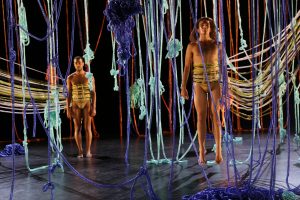
Charles Atlas / Rashaun Mitchell / Silas Riener, Tesseract. Pictured from left to right: Rashaun Mitchell and Silas Riener. Photo: © Mick Bello / EMPAC
The strongest sections are the opening one with dancers costumed and made up in black and white, performing around a black and white set, also by Mitchell and Riener. There is a beautiful duet with Hiroki Ichinose and Melissa Toogood where they danced in close proximity but never actually touched. There is an amazing section where the dancers dressed in vibrant, saturated colors of blue, gold, yellow, red and green. Here, the set resembles artfully folded triangles of these same colors, and with mirrors and cinematography magic, they all morph into a beautiful, living kaleidoscope. The last section featuring Mitchell and Riener was interesting with it hanging plastic ropes and animalistic costumes, but it suffered because of its length. The beautiful cast for the film includes David Rafael Botana, Kristen Foote, Hiroki Ichinose, Cori Kresge, Rashaun Mitchell, Silas Riener, and Melissa Toogood.
The second half of TESSERACT is visually exquisite, and it is a cohesive work that produces amazing real-time video projections and pre-shot film footage. Dressed in red, the Steadicam operator, Ryan Thomas Jenkins, opens the work by demonstrating how the Steadicam is set up and harassed onto his body. It is an amazing piece of equipment invented by Garrett Brown and introduced in 1975 by Cinema Products Corporation. It allows the cameraman to move about freely without causing the camera to shake. It floats freely out in front of him as he moves about the stage filming the dancers, and becoming one of the performers.
Six beautiful dancers perform Mitchell and Riener’s choreography with clarity and professional ease. There is a long rhythmic running section built on seven counts, that forms and moves through the geometric patterns first seen in the film. This shifts into solos, duets and group sections where their movement is projected in real time onto the downstage scrim. Stationary figures appear to simultaneously fly across the space. They transform into cartoon-like drawings or become primary colored figures that allow a woman to perform in canon with herself.
The dance/live video feed never becomes stale. It moves into bigger and better areas, pushing the boundaries of dance on film. It changes one’s perspective of not only the work, but of the reality happening right in front of us. The incredible cast includes David Rafael Botana, Eleanor Hullihan, Kate Jewett, Cori Kresge, Ryan Thomas Jenkins, Rashaun Mitchell, and Silas Riener.
The list of film and production crew is too long to include here, but a few need to be mentioned. Music score for the film is by Fennesz, the Lighting Direction by Dan Swalec and the Master Carpentry and Rigging by William Fritz. For the second half, the music is by Mas Ysa, inventive video by Charles Atlas, amazing lighting by Davison Scandrett and gorgeous costumes by Mitchell, Riener with Mary Jo Mecca and Yvette Helin.
TESSERACT runs through Sunday, December 3, 2017 at REDCAT. For information and tickets, click here.
To view the LA Dance Chronicle Performance Calendar, click here.
Feature Photo: Roger Martin Holman
